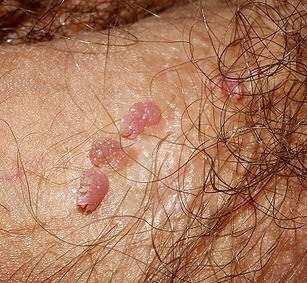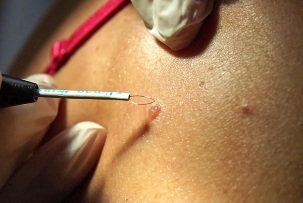
Generally, people do not suspect that they have human papillomavirus (HPV) in their body. This is because the papillomavirus is usually suppressed by natural immunity and is latent. Problems arise when it gets out of control and becomes active in various parts of the body in the form of growth. The virus affects men less than women, but for them, its effects can become a serious problem in the form of penile papillomas.
Causes
Viral DNA enters the body through microcracks in the skin or mucous membranes. If a man's immunity is reduced, the first signs of HPV appear a few months after infection.
Up to 80% pass through sexual intercourse. Barrier contraception minimizes the risk of infection, but does not completely eliminate it.
Other ways of infection:
- way of life.The virus is transmitted through the personal belongings of an infected person: clothing, hygiene items, etc. b. If you damage the skin, the risk of infection increases, even in small children. This route is characterized by infection with non-oncogenic strains of the virus. They do not cause serious health problems, but appear in the form of warts, papillomas and warts on the genitals, causing cosmetic defects.
- mother to child.If a mother is infected with the HPV virus during pregnancy and childbirth and gives birth naturally, the baby can be infected.
If a man's immune system is good, the virus will not show itself and may remain secreted in the body for a long time. Therefore, it is not the virus itself that is infected, but the weakened immune system that causes HPV to become active.
There are a number of factors that affect the ability to strengthen the position of the virus:
- chronic diseases;
- hormonal problems;
- incorrectly chosen contraception or its complete absence;
- viral infections;
- alcohol, smoking or long-term use of antibiotics;
- a lot of stress.
All of these factors have a negative effect on the immune system. If a man's life is not the only provocative factor, but there are several factors, it will lead to the rapid development of papillomavirus.
characters
In most cases, papillomas appear only externally, but in some casesNon-specific characters may appear:
- itching and burning during sex;
- pain when touching papilloma;
- Concentration of urine in the folds of the penis;
- Unpleasant odor in the affected area.
In addition, neoplasms grow and affect not only the genital area, but also the perforation and the intestines.

What do papillomas look like
Genital papilloma is a small neoplasm. At first, it may appear alone, but if left untreated, papillomas can increase. However, they can be combined with each other.
These plants look like flesh or pink cauliflower wreaths. They are usually localized in the bone, head and phrena. They are usually detected in the urine and sputum. Papillomas can also appear as small white pimples that appear in long rows. This form is typical for localization in the area of restraint.
One of the manifestations of HPV is the Bushke-Levenstein wart. It is characterized by rapid growth, remarkable size and resistance to various types of treatment. Its formation is associated with several existing papillomas and warts, which combine to form a large purulent zone. The presence of condyloma is dangerous for Bushke-Levenstein, because these altered cells can turn into cancer.
Which doctor to contact
As a rule, a urologist diagnoses papilloma in men. You can also consult a dermatovenerologist or proctologist if there are bones in the genitals in the anal area. However, papillomas are usually referred to a surgeon for removal. In general, the diagnosis is made in several stages:
- A urologist examines and interviews a patient.Oral surveys are needed to assess a patient's lifestyle and determine the cause of the infection. Visual inspection includes not only the assessment of the condition of the penis, but also the adjacent organs - the skeleton and anal area. This is necessary to complete the picture of the localization of the virus.
- Urethral smear.Detects the presence of various sexually transmitted diseases.
- PCR.This test not only detects the presence of HPV in the body, but also detects its type.
- Metoscopy.This procedure scans the inside of the urethra if the papillomavirus is infected. After removing the
- papilloma, the doctor may order a biopsyto assess the condition of the tumor. This is to rule out the risk of cancer and to make sure the papilloma is benign.
In this case, it is better to conduct a survey of both partners. A woman is usually infected with one of the types of papillomavirus. If only a man is treated, he may soon become ill again.
Why Papillomas Are Dangerous
Human papillomavirus is often associated with other related diseases. The formation of papillomas in the genital area promotes the accumulation of folded urine. This promotes the formation and growth of various microorganisms, which then lead to infections. They can cause erosion around the papilloma and cause inflammation of the urethra and testicles. These diseases are characterized by urination, pain and fever.
Another danger is the trauma of neoplasms that lead to bleeding. This is because many blood vessels form around the papillomas, supplying them with blood. Even minor injuries can lead to infection.
Also, neoplasms can be rubbed off when moving, which can cause pain and discomfort for men.
HPV and cancer
When the virus is just beginning to spread, neoplasms are rare and benign. When left untreated, they can grow and coalesce. In time, the cells break down and become harmful cells.If a man is infected with 16 or 18 oncogenic types of the virus, the risk of cancer is higher.They cause cancer of the penis and bladder.
Treatment of papillomas
Treatment for HPV involves not only removing its appearance, but also strengthening the immune system, which must suppress the appearance of the virus.Immunostimulatory drugs are used to maintain immunity.
As an antiviral drug, oils that inhibit viral replication and reduce growth are effective. It does not always solve the problem of complete removal, but it does not allow new growths to occur. Antiviral ointment is prescribed to boost immunity. The oil does not remove papillomas, but stimulates the immune system, which stops their growth and development.

How to delete
There are several ways to get rid of emerging growths:
- Laser destruction.Laser light affects the papilloma, which completely burns the growth. Here a crust forms and wears off after a few weeks. The method is considered effective in the absence of relapses. Removal is performed under anesthesia. No blood, no scars and scars.
- Cryodestruction.Papillomas are exposed to liquid nitrogen. It instantly freezes any area, and the neoplasm in it collapses and disappears. The disadvantage of this method is the inability to control the depth of the cryodestruction effect. At the site of the papilloma, there is still a crust that disappears after a while.
- Radiosurgery.The principle of this method is similar to laser cleaning. Radio waves do not leave scars and scars, and pre-anesthesia with a special spray before the procedure. Then there will be no problems and the body will recover quickly.
- Electrocoagulation.Growth is affected by an electric current, as a result of which the foot is removed, and then the papilloma disappears. If necessary, superficial anesthesia can be given. The procedure takes a few minutes, is common and affordable. However, this method is able to leave scars after healing.
- Surgical intervention.It is rarely used when the tumor is very large. It is performed under anesthesia, heals and injures for a long time. The method is good because it allows to preserve the growth removed for histological examination.
The cost of each method depends on the complexity of the procedure, the size and number of papillomas removed.
Before choosing a method, consult your doctor. He will tell you in detail what is best to use in your situation and how the procedure is performed. It is also advisable to take the material for histology after removal of the neoplasm. This is necessary to determine whether benign neoplasms have begun to develop into malignant tumors. This method detects early cell changes and prevents the spread of cancer.














































































